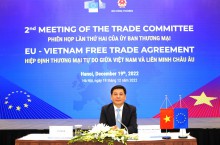The News
Characteristics and market development trends for some typical products in Portugal
For many years, Vietnam has always had a trade surplus to Portugal, the export turnover (2020) is nearly 9 times larger than the import turnover. Seafood, phones and components, coffee, computers, electronic products and components are the main export groups of Vietnam to Portugal. Vietnam's imports from Portugal are small, mainly textile-footwear accessories, chemicals, machinery, equipment, pharmaceuticals.
For many years, Vietnam has always had a trade surplus to Portugal, the export turnover (2020) is nearly 9 times larger than the import turnover. Seafood, phones and components, coffee, computers, electronic products and components are the main export groups of Vietnam to Portugal. Vietnam's imports from Portugal are small, mainly textile-footwear accessories, chemicals, machinery, equipment, pharmaceuticals.
1.Portuguese market characteristics
Major agricultural products include cereals, potatoes, tomatoes, olives, grapes, sheep, cattle, goats, pigs, chickens, dairy products, fish.
Portugal is a land of fruits, wines and trees. The majority of the Portuguese population works in some area of agriculture. Grapes (for eating and for making wine) and olives are grown everywhere. Cereals are mainly oats and rice. Apples, pears, peaches, citrus are grown for export. Tomatoes for processing into tomato sauce, are another fruit. Portugal is not self-sufficient in food, so it imports nearly half of its food, including wheat, corn and meat.
The main economic sectors include: textiles and footwear, wood pulp, paper, cork oak shell products, metals and mechanics, oil refining, chemicals, canning (meat, fish), rubber and plastic products, pottery, electronics and communication equipment, rail transport equipment, equipment for aerospace, construction and repair of variable ships, alcohol, travel.
Portugal has significant natural resources, but industrialization is at a normal level . Portugal's main industrial products are textiles and clothing (with about 1/3 of production exported), canned sardine fish, tuna, crushed tomatoes, cement, pulp, chemical fertilizers and refined olive oil. Energy for industry is mainly provided by hydroelectric power plants in the northern mountains. The country's industry depends mainly on imported energy and raw materials.
Tourism yields about 8% of gross domestic product, with the majority of tourists coming from Spain and the UK with the Algarve being the leading tourist centre.
FDI is considered a top priority of the Portuguese government. Portugal has recently promoted the development of renewable energy sources, especially solar energy (the country has the second largest solar power plant in the world) and wave energy (obtained from ocean waves). These sectors provide new opportunities for foreign investors. Portugal has a diverse economy and many benefits from being a member of the European Union.

2. Bilateral trade relations between Vietnam and Portugal
Although bilateral trade turnover is still modest, it grows steadily every year. According to the Portuguese Statistical Office, two-way trade in 2010 only reached 75 million euros, by 2019, two-way trade turnover has increased to 408 million euros. In 2020, due to the impact of the Covid-19 epidemic, bilateral trade between Vietnam and Portugal was negatively affected, bilateral import and export turnover reached 348 million euros. In the first 7 months of 2021, the total bilateral trade turnover reached 271.6 million euros, of which exports reached 213.2 million euros, up 20.7% and exports reached 58.4 million euros, up 171.7% over the same period in 2020.
For many years, Vietnam has always had a trade surplus to Portugal, the export turnover (2020) is nearly 9 times larger than the import turnover. Seafood, phones and components, coffee, computers, electronic products and components are the main export groups of Vietnam to Portugal. Vietnam's imports from Portugal are small, mainly textile-footwear accessories, chemicals, machinery, equipment, pharmaceuticals.
In the first 10 months of 2022, the total import-export turnover between Vietnam and Portugal reached 534.6 million USD, down 6.29% over the same period last year. Specifically:
- Exports reached 454.2 million USD, down 0.55% over the same period last year;
- Imports reached 80.4 million USD, down 29.3%;
- Vietnam has a trade surplus of 373.8 million USD to Portugal in the first 10 months of 2022.
In 2021, according to the General Department of Vietnam Customs, two-way trade between Vietnam and Portugal reached 690.3 million USD, up 31.8% compared to 2020. Vietnam's export turnover to Portugal reached 564.7 million USD, up 50.1% compared to 2020; Vietnam's imports from Portugal reached 125.6 million USD, up 32.5%.
The structure of goods between Vietnam and Portugal is complementary and less competitive. In the first 10 months of 2022, Vietnam's main exports to Portugal include: Phones and components (reaching 154 million USD, accounting for nearly 34%), Seafood (reaching 37.4 million USD, accounting for 8.2%), Computers, electronic products and components (reaching 35.4 million, accounting for 7.8%). Imports from Portugal have a turnover of 80.4 million USD.



